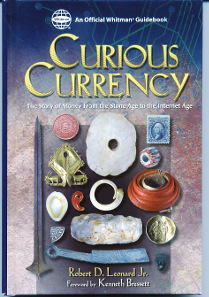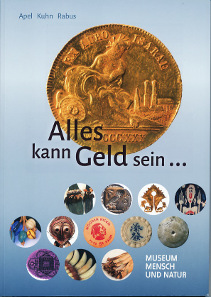By Ursula Kampmann
June 26, 2014 – Hardly anything kindles a greater interest in the laypeople than a showcase exhibiting the things that used to serve as money in the past and the present. Cigarettes and whiskey bottles, animal furs and boar teeth, tea bricks and cocoa beans both fascinate and invite to reflect upon the essence of money.
Robert D. Leonard Jr., Curious Currency. The Story of Money From the Stone Age to the Internet Age. Whitman Publishing, Atlanta, GA, 2010. 23.6 x 16 cm, 158 p. full colour throughout. Hardcover. ISBN: 978-0794822897. $12.95.
Who wants to get an overview about which materials and kinds of objects had already been used as money is recommended to have a look at the catalog “Curious Currency” written by Robert D. Leonard and published by Whitman. He provides a cross-cultural outline – that is not intended to be exhaustive – by arranging forms of pre-monetary money according to object categories.
His first chapter deals with the archetype of barter: raw material, hence stones and metals for processing, the kind of money that basically became the very first evolutionary stage of our money.
The second chapter is the most comprehensive one. It bears the plain title “Useful Articles” and subsumes the farming world where cattle, crop and slaves served as means of barter. It likewise addresses agricultural produce as well as long-life food, fabrics and tools, weapons and furs, alcohol, drugs, cigarettes and stamps.
Next up are what we know as classic forms of pre-monetary money, i.e. everything that decorates. Firstly, pearls and pearl necklaces, feathers, rings, crustaceans and animal teeth. It is hard to distinguish them from what Leonard calls “Customary Objects”, hence shrink former utility objects that have become established trade units. A classic example of a “Customary Object” would be the manille, strictly speaking a bracelet that has become unwearable and was not produced for use. This chapter also lists some special coins while the last chapter focuses on all kinds of token money.
Leonard’s goal was to write an entertaining book that makes the reader marvel and want to read more. Classification sometimes falls by the wayside but on the other hand the book with its lexicon-like structure (the index of subjects at the end is very handy!) gives a wonderful overview of the material.
Michael Apel, Günter Kuhn, Bernhard Rabus, Alles kann Geld sein … … man muss nur daran glauben. Museum Mensch und Natur, 2014. 29.6 x 21 cm. 94 p., full colour throughout. Paperback. 17.50 euros (available in the museum shop).
A much more theoretical approach is taken by the book “Alles kann Geld sein” (Anything can be money) by Michael Apel, Günter Kuhn and Bernhard Rabus whose additional caption “…man muss nur daran glauben” (you just have to believe in it) already includes the criticism of money. Already the introduction makes clear that the emphasis is not on individual kinds of pre-monetary money. It is about the money we all use. Coins, bank notes, credit cards and bankbooks are on a par with mamulis, sycees, mokkos, cowries and cigarettes, even in regard to purchasing power, monetary stability and inflation.
A cross-cultural approach was taken here, too. The classification criterion – which is systematically adhered to – is the material. Divided into gold, silver, copper / bronze / brass, iron, nickel / aluminium, stone, glass / ceramics, salt, shells of molluscs, other animal raw materials, tobacco, tea / cocoa, things plaited and woven, wood / leaves and paper, the markedly short minimal texts provide interesting and surprising facts to anyone.
The target audience clearly is the layman, perhaps even the up-and-coming young numismatist. As a result, the catalog of the exhibition bearing the same title of the Museum “Mensch und Natur” comes in an extraordinarily fresh design and is only faintly reminiscent of a traditional book. Anyone expecting a lengthy treatise, however, might very well be disappointed. The authors have taken the direction the current textbooks for children (which, by the way, are very popular with adults as well) move in to a logical conclusion. The primary focus is on the image that is accompanied by a short description that can be read easily and quickly. The texts are plain, do not contain so many foreign words and hence reject the usual technical jargon.
Both books are ideally suited to win the pre-monetary money more collectors and raise a greater awareness for money as a topic.





